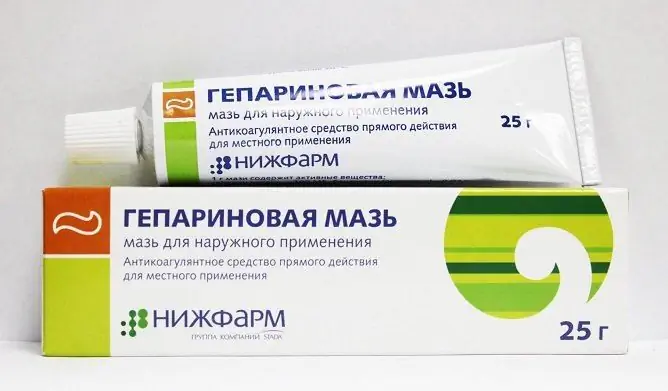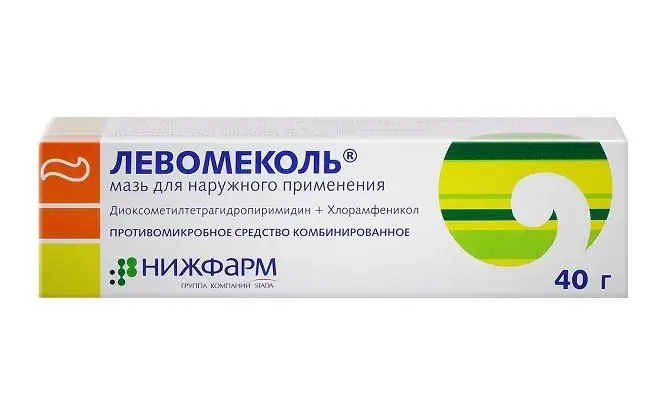- Author Rachel Wainwright [email protected].
- Public 2023-12-15 07:39.
- Last modified 2025-11-02 20:14.
Mekol
Mekol: instructions for use and reviews
- 1. Release form and composition
- 2. Pharmacological properties
- 3. Indications for use
- 4. Contraindications
- 5. Method of application and dosage
- 6. Side effects
- 7. Overdose
- 8. Special instructions
- 9. Application during pregnancy and lactation
- 10. Use in childhood
- 11. Drug interactions
- 12. Analogs
- 13. Terms and conditions of storage
- 14. Terms of dispensing from pharmacies
- 15. Reviews
- 16. Price in pharmacies
Latin name: Mekol
ATX code: D06С
Active ingredient: chloramphenicol (Chloramphenicol), methyluracil (Methyluracil)
Manufacturer: JSC "Borisov Plant of Medical Products" (JSC "BZMP") (Republic of Belarus)
Description and photo update: 2019-09-07

Mekol is a combined antimicrobial agent for topical use.
Release form and composition
The drug is available in the form of an ointment for external use: a mass of white with a yellow tinge or white (40 g each in aluminum tubes, 1 tube in a cardboard box and instructions for using Mekol).
40 g of ointment contains:
- active ingredients: chloramphenicol - 0.3 g; methyluracil - 1.6 g;
- auxiliary components: macrogol-400, macrogol-1500.
Pharmacological properties
Pharmacodynamics
Mekol is a combined topical preparation with antimicrobial, anti-inflammatory and reparative effect.
The mechanism of action of the drug is due to the properties of its active ingredients:
- chloramphenicol (chloramphenicol): disrupting the synthesis of proteins of microorganisms, has a bacteriostatic effect. It is active against such gram-positive and gram-negative microorganisms as staphylococcus, streptococcus, E. coli and Pseudomonas aeruginosa;
- methyluracil: has an anti-inflammatory effect, helps to accelerate the processes of cell regeneration and scarring of wounds.
The polyethylene oxide base of the ointment potentiates the activity of chloramphenicol and methyluracil, adsorbs wound exudate. Easily penetrating into tissues, the drug does not violate the integrity of biological membranes. The degree of systemic absorption of the ointment has not been established.
Pharmacokinetics
The active ingredients of the Mekol ointment poorly penetrate through intact skin and mucous membranes.
After applying chloramphenicol to damaged areas of the skin or mucous membranes, in the cavity and wound channels, its absorption occurs. The substance is determined in the blood after 4-5 hours, crosses the blood-brain and placental barriers, and enters breast milk. Chloramphenicol is a cytochrome P 450 inhibitor. It is excreted through the kidneys in the form of inactive metabolites, to an insignificant extent through the intestines.
Methyluracil accumulates at the site of application of the ointment and practically does not have a resorptive effect.
Indications for use
The use of Mekol is indicated for the treatment of purulent-necrotic wounds, including lesions infected with mixed microflora.
Contraindications
- malignant neoplasms of the skin;
- fungal skin diseases;
- psoriasis;
- eczema;
- metastatic trophic skin lesions;
- During pregnancy and breastfeeding;
- age up to 3 years;
- hypersensitivity to the components of Mekol ointment.
Mecol, instructions for use: method and dosage
Mekol ointment is intended for external use. It is applied to sterile gauze wipes that fill the wound surface. In addition, the introduction of ointment into purulent cavities is shown. In this case, it should be warmed up to 35-36 ° C and injected directly into the cavity with a syringe through a catheter or drainage tube.
It is recommended to apply the ointment from the moment of injury every day, continuing to make dressings until the wound is completely cleared of purulent-necrotic masses and the beginning of their granulation, but no more than 4 days.
The maximum daily dose of the ointment in terms of chloramphenicol (chloramphenicol) is 3 g.
Long-term use of Mekol can cause osmotic shock in intact cells. Therefore, from 5-7 days, it is recommended to change the treatment regimen using drugs that restore the integrity of damaged tissues.
Side effects
- from the digestive system: flatulence, diarrhea, nausea, vomiting;
- from the hematopoietic system: leukopenia, agranulocytosis, thrombocytopenia, aplastic anemia, reticulocytopenia;
- from the nervous system: headache, peripheral neuritis;
- local reactions: irritation at the site of application, contact dermatitis;
- hypersensitivity reactions: itching, burning, skin rash, urticaria, angioedema.
Overdose
- symptoms: contact sensitization that occurs during the use of the ointment for more than 5-7 days. It may be accompanied by the development of hypersensitivity reactions with repeated use of the drug, both externally and in the form of dosage forms for systemic treatment;
- treatment: if necessary, the appointment of symptomatic therapy.
special instructions
The antibacterial effect of the ointment remains in the presence of pus or necrotic masses in the wound.
It should be borne in mind that long-term external use of antibacterial agents is associated with the risk of developing skin sensitization, which may be accompanied by the occurrence of hypersensitivity reactions in the patient, arising from the repeated use of agents containing chloramphenicol of external or systemic action.
Do not allow the ointment to get on the mucous membrane of the eyes.
If it is necessary to use Mekol for more than one month, regular monitoring of the state of the peripheral blood picture is required.
Influence on the ability to drive vehicles and complex mechanisms
Mekol does not adversely affect the patient's ability to drive vehicles.
Application during pregnancy and lactation
The use of Mekol is contraindicated during the period of gestation and breastfeeding.
Pediatric use
The use of Mekol is contraindicated for the treatment of children under the age of three years.
Drug interactions
Mecol is incompatible with barbiturates and ethanol. In addition, the simultaneous use of ointment with drugs that inhibit hematopoiesis - cytostatics, sulfonamides, pyrazolone derivatives should be avoided.
Analogs
Mekol's analogues are Mekol-Borimed, Levomycetin, Levomycetin sodium succinate, Levomycetin-AKOS, Levovinisol, Chloramphenicol sodium succinate sterile, Levomycetin-LekT, Levomycetin Aktitab, Syntomycin, Levomekolin, Levomethyl, Levomethyl.
Terms and conditions of storage
Keep out of the reach of children.
Store at temperatures up to 20 ° C.
The shelf life is 3.5 years.
Terms of dispensing from pharmacies
Available without a prescription.
Reviews about Mekola
There are currently no reliable reviews about Mekol from patients or specialists, on the basis of which it would be possible to draw conclusions about the effectiveness and safety of using the ointment.
Price for Mecol in pharmacies
The price for Mekol has not been set due to the lack of the drug in the pharmacy chain.

Anna Kozlova Medical journalist About the author
Education: Rostov State Medical University, specialty "General Medicine".
Information about the drug is generalized, provided for informational purposes only and does not replace the official instructions. Self-medication is hazardous to health!






